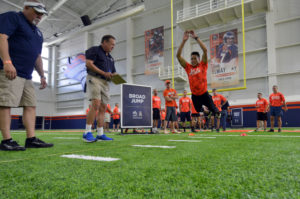Pitchers Don’t NEED To Run…At All
Pitchers and running have gone together for a long time, but luckily, thanks to Eric Cressey and others, that’s changing. In the past (and in some cases, currently) a typical practice for pitchers, might have included some light throwing, or even some long toss, some fielding work, then maybe a bullpen, and then running poles.
Poles are used for conditioning and recovery, and as an added bonus they kill time when coaches can’t find anything else for pitchers to do. The thinking is that running will help pitchers recover faster between starts or relief appearances, and that isn’t totally incorrect, as light aerobic activity can speed recovery, but there are better ways to achieve this than distance running (see my post about mobility circuits here).
Distance running has very little carry over to pitching because it’s steady state activity-you move at a submaximal effort for an extended period of time-whereas, pitching is repeated bouts of maximal effort movement. There are a host of other reasons you shouldn’t run poles that you can read about here.
Sprints can get pitchers moving fast, and at least primarily use the right energy system (ATP-CP), and muscle fiber types (type II-fast twitch), however, there are other movements that also require pitchers to move fast and have more carry over to pitching. Sprints aren’t bad, they just aren’t the most efficient use of pitchers’ limited time and energy. Pitchers already have to work on their sport specific skills (velocity, command, and movement), strength/power, and mobility, so adding another demand to this list doesn’t make a ton of sense, especially since it is not a pattern they need for elite on-field performance.
Here are some alternatives I have my athletes use instead of sprints:
Lateral Bounds: They teach pitchers to move powerfully in the frontal plane, and more strongly correlate with pitching velocity. Here is a basic version that can help teach athletes how to create and accept force by having them stick the landing:
Other Jumping Variations: Broad jumps, bounce-drop variations, and even some vertical jump variations could fit in here as they all help with RFD (rate of force development).
Medicine Ball Throws: Medicine ball throw variations allow athletes to move at a very high speed without slowing down at the end of the movement because they release the ball. Moving the bar fast on a squat or press is great, but they are only moving it fast for a relatively small percentage of the entire movement-the bar has to slow down at the end of the range of motion since they are not releasing the bar.
Note: This is intended for advanced level athletes (more than five years training experience)-mainly college and professional pitchers who have already built their general movement base (see my specificity article here.)
Resources
Photo:
“Schriever Airmen train like Broncos” by Staff Sgt. Debbie Lockhart

